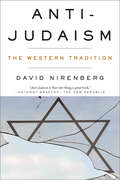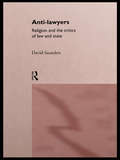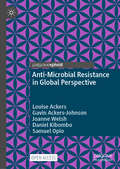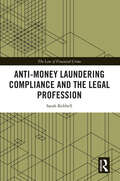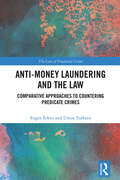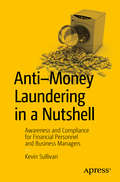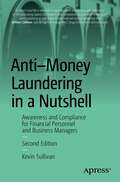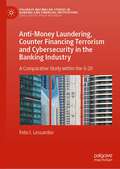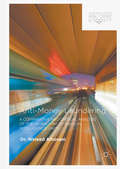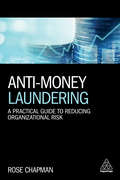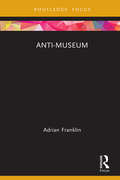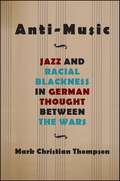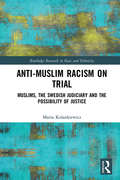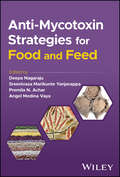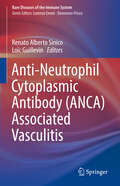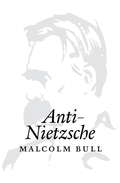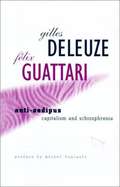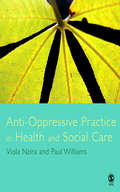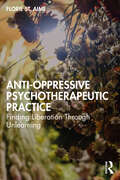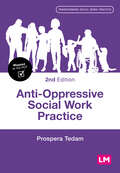- Table View
- List View
Anti-Judaism: The Western Tradition
by David Nirenberg"Exhilarating . . . a scholarly tour de force. The story Nirenberg has to tell is not over."--Adam Kirsch, Tablet This incisive history upends the complacency that confines anti-Judaism to the ideological extremes in the Western tradition. With deep learning and elegance, David Nirenberg shows how foundational anti-Judaism is to the history of the West. Questions of how we are Jewish and, more critically, how and why we are not have been churning within the Western imagination throughout its history. Ancient Egyptians, Greeks, and Romans; Christians and Muslims of every period; even the secularists of modernity have used Judaism in constructing their visions of the world. The thrust of this tradition construes Judaism as an opposition, a danger often from within, to be criticized, attacked, and eliminated. The intersections of these ideas with the world of power--the Roman destruction of the Second Temple, the Spanish Inquisition, the German Holocaust--are well known. The ways of thought underlying these tragedies can be found at the very foundation of Western history.
Anti-Lawyers: Religion and the Critics of Law and State
by David SaundersIn early modern Europe the law developed as one of the few non-religious orderings of civil life. Its separation from religion was, however, never complete and we see the contest continued today not only in the campaigns of religious fundamentalists of the right, but also in the clains of critical intellectuals to reshape government institutions and the legal apparatus in accordance with moral principle - whether of indivudual autonomy or communitarian self-determination. In Anti-Lawyers, David Saunders traces the story of this unresolved conflict from Hobbes' Leviathan to the American law texts of today, and discusses how we might regard today's moral critics of government and law in the light of the early modern effort to disengage spiritual discipline from secular government and conscience from law. Separate sections look at major figures in English common law in the Early Modern period, French and German absolutism and jurisprudence as it is taught in the American law texts of today.
Anti-Microbial Resistance in Global Perspective
by Louise Ackers Gavin Ackers-Johnson Joanne Welsh Daniel Kibombo Samuel Opio‘The Maternal Sepsis Intervention has had a profound impact on maternal mortality and antibiotic use whilst also reducing hospital costs. The Ministry of Health is keen to explore opportunities to extending the lessons learnt and integrate them in national policy-making.' -Dr. Richard Mugahi, Ministry of Health, Uganda. This open access book provides an accessible introduction to the mechanics of international development and global health text for policy-makers and students across a wide range of disciplines. Antimicrobial resistance is a major threat to the well-being of patients and health systems the world over. In fragile health systems so challenged, on a day-today basis, by the overwhelming burden of both infectious and non-communicable disease, it is easy to overlook the impacts of AMR. The Maternal Sepsis Intervention, focusing on a primary cause of maternal death in Uganda, demonstrates the systemic nature of AMR and the gains that can be made through improved Infection Prevention Control and direct engagement of laboratory testing in antibiotic prescribing.
Anti-Money Laundering Compliance and the Legal Profession (The Law of Financial Crime)
by Sarah KebbellMoney laundering is a global issue and there is evidence that the services provided by the legal profession may be misused to launder the proceeds of crime. This book explores the experiences of professionals within Top 50 law firms when seeking to comply with the UK’s anti-money laundering (AML) regime. The book draws upon empirical evidence from 40 in-depth interviews with solicitors and compliance personnel from 20 Top 50 law firms. Access to this section of the legal profession is challenging in the context of academic research, and the research provides an account, seldom heard in academic literature, directly from practitioners. The book uses these research findings to explore and discuss the AML compliance issues faced by this section of the profession. It highlights the challenges presented by the legislative architecture of the Proceeds of Crime Act 2002, and considers compliance issues relating to customer due diligence, AML training, the client account and the suspicious activity reporting regime. It also considers participants’ perceptions of the regime, their role within it, and their own assessment of money laundering risk. It concludes by using this evidence to recommend amendments to current AML policy and legislation. This book will be of interest to students and researchers studying Financial Crime Law, Business and Company Law, and White Collar Crime, as well as policy makers in the areas of money laundering, compliance, and corruption.
Anti-Money Laundering Transaction Monitoring Systems Implementation: Finding Anomalies (Wiley and SAS Business Series)
by Derek Chau Maarten van NemcsikEffective transaction monitoring begins with proper implementation Anti-Money Laundering Transaction Monitoring Systems Implementation provides comprehensive guidance for bank compliance and IT personnel tasked with implementing AML transaction monitoring. Written by an authority on data integration and anti-money laundering technology, this book offers both high-level discussion of transaction monitoring concepts and direct clarification of practical implementation techniques. All transaction monitoring scenarios are composed of a few common elements, and a deep understanding of these elements is the critical factor in achieving your goal; without delving into actual code, this guide provides actionable information suitable for any AML platform or solution to help you implement effective strategies and ensure regulatory compliance for your organization. Transaction monitoring is increasingly critical to banking and business operations, and the effectiveness of any given solution is directly correlated to its implementation. This book provides clear guidance on all facets of AML transaction monitoring, from conception to implementation, to help you: Detect anomalies in the data Handle known abnormal behavior Comply with regulatory requirements Monitor transactions using various techniques Regulators all over the world are requiring banks and other companies to institute automated systems that combat money laundering. With many variables at play on both the transaction side and the solution side of the equation, a solid understanding of AML technology and its implementation is the most critical factor in successful detection. Anti-Money Laundering Transaction Monitoring Systems Implementation is an invaluable resource for those tasked with putting these systems in place, providing clear discussion and practical implementation guidance.
Anti-Money Laundering and the Law: Comparative Approaches to Countering Predicate Crimes (ISSN)
by Umut Turksen Engin ErkenThis book provides a distinctive and critical analysis of the anti-money laundering (AML) measures that have been put in place in Türkiye and the United Kingdom.The work presents a comparative analysis of if, and to what extent, the AML regimes in these jurisdictions are fit for purpose in countering some of the most pressing predicate crimes. It investigates the AML regimes relating to tackling the riskiest/most prevalent predicate crimes, that is, drug trafficking and tax crimes, thereby filling a significant gap within the current literature. The study provides insights into the effectiveness and efficiency of national AML frameworks adopted by Türkiye and the UK in addressing distinct crimes, thereby identifying essential features of an optimum AML ecosystem that could effectively address predicate crimes regardless of their nature. This novel approach offers a detailed analysis of the law in books and law in practice elements of the AML regimes in Türkiye and the United Kingdom which will set the tone for conducting similar studies in other jurisdictions.The book will be of interest to academics, researchers and policy-makers working in the areas of Financial Crime, Law Enforcement and Comparative Law.
Anti-Money Laundering in a Nutshell: Awareness and Compliance for Financial Personnel and Business Managers
by Kevin SullivanAnti-Money Laundering in a Nutshellis a concise, accessible, and practical guide to compliance with anti-money laundering law for financial professionals, corporate investigators, business managers, and all personnel of financial institutions who are required, under penalty of hefty fines, to get anti-money laundering training. Money laundering is endemic. As much as 5 percent of global GDP ($3. 6 trillion) is laundered by criminals each year. It''s no wonder that every financial institution in the United States--including banks, credit card companies, insurers, securities brokerages, private funds, and money service businesses--must comply with complex examination, training, and reporting requirements mandated by a welter of federal anti-money laundering (AML) laws. Ignorance of crime is no excuse before the law. Financial institutions and businesses that unknowingly serve as conduits for money laundering are no less liable to prosecution and fines than those that condone or abet it. In Anti-Money Laundering in a Nutshell: Awareness and Compliance for Financial Personnel and Business Managers, Kevin Sullivan draws on a distinguished career as an AML agent and consultant to teach personnel in financial institutions what money laundering is, who does it, how they do it, how to prevent it, how to detect it, and how to report it in compliance with federal law. He traces the dynamic interplay among employees, regulatory examiners, compliance officers, fraud and forensic accountants and technologists, criminal investigators, and prosecutors in following up on reports, catching launderers, and protecting the integrity and reputations of financial institutions and businesses. In particular, corporate investigators will gain rich insights winnowed from the author''s experiences as a New York State and federal investigator. What you''ll learn US federal and international AML laws The AML measures and program that financial institutions must have in place to control money laundering, such as KYC, CIP, and AML/CFT risk assessment The practical steps that personnel at every level from the teller window to the C-suite must know to ensure institutional compliance with AML regulations, such as filling out SARs and CTRs Who this book is for Under federal acts such as the Bank Secrecy Act of 1970, the Money Laundering Suppression Act of 1994, and the Intelligence Reform and Terrorism Prevention Act of 2004, every financial institution in the United States must have an anti-money laundering program in place that includes annual training of all relevant employees. This short book is an educational text or supplemental reader for such training by anti-money laundering compliance officers, examiners, agents, and consultants. Table of Contents Chapter 1. What is Money Laundering? Chapter 2. Methods of Money Laundering Chapter 3. Federal Regulations Chapter 4. Building a Quality AML Program for Financial Institutions Chapter 5. Know Your Customer and Customer Identification Program Chapter 6. A SAR Is Born Chapter 7. Money Laundering for Law Enforcement Chapter 8. International Standards Chapter 9. FRAML Glossary Appendix A: Red Flags Appendix B: Code of Federal Regulations Title 31 Section 103. 18
Anti-Money Laundering in a Nutshell: Awareness and Compliance for Financial Personnel and Business Managers
by Kevin SullivanAnti–Money Laundering in a Nutshell is a concise, accessible, and practical guide to compliance with anti–money laundering law for financial professionals, corporate investigators, business managers, and all personnel of financial institutions who are required, under penalty of hefty fines, to get anti–money laundering training. This new edition of Anti-Money Laundering will update the topics discussed, and introduce the changes and updates including information on the AMLA Act of 2020, new EU standards and directives, anti-money laundering on digital currencies and more.Money laundering is endemic. As much as 5 percent of global GDP ($3.6 trillion) is laundered by criminals each year. It’s no wonder that every financial institution in the United States—including banks, credit card companies, insurers, securities brokerages, private funds, and money service businesses—must comply with complex examination, training, and reporting requirements mandated by a welter of federal anti–money laundering (AML) laws. Ignorance of crime is no excuse before the law. Financial institutions and businesses that unknowingly serve as conduits for money laundering are no less liable to prosecution and fines than those that condone or abet it.In Anti–Money Laundering in a Nutshell: Awareness and Compliance for Financial Personnel and Business Managers, Kevin Sullivan draws on a distinguished career as an AML agent and consultant to teach personnel in financial institutions what money laundering is, who does it, how they do it, how to prevent it, how to detect it, and how to report it in compliance with federal law. He traces the dynamic interplay among employees, regulatory examiners, compliance officers, fraud and forensic accountants and technologists, criminal investigators, and prosecutors in following up on reports, catching launderers, and protecting the integrity and reputations of financial institutions and businesses. In particular, corporate investigators will gain rich insights winnowed from the author's experiences as a New York State and federal investigator.
Anti-Money Laundering, Counter Financing Terrorism and Cybersecurity in the Banking Industry: A Comparative Study within the G-20 (Palgrave Macmillan Studies in Banking and Financial Institutions)
by Felix I. LessamboDespite massive investments in mitigation capabilities, financial crime remains a trillion-dollar global issue with impacts that extend well beyond the financial services industry. Worldwide, there are between $800 billion and $2 trillion laundered annually with the United States making up at least $300 billion of that figure. Although it is not possible to measure money laundering in the same way as legitimate economic activity, the scale of the problem is considered enormous. The cybersecurity landscape is always shifting, with threats becoming more sophisticated all the time. Managing risks in the banking and financial sectors requires a thorough understanding of the evolving risks as well as the tools and practical techniques available to address them. Cybercrime is a global problem, which requires a coordinated international response. This book outlines the regulatory requirements that come out of cyber laws and showcases the comparison in dealing with AML/CFT and cybersecurity among the G-20, which will be of interest to scholars, students and policymakers within these fields.
Anti-Money Laundering: A Comparative and Critical Analysis of the UK and UAE's Financial Intelligence Units (Palgrave Studies in Risk, Crime and Society)
by Waleed AlhosaniThis book critically analyses the role of theUnited Arab Emirates Financial Intelligence Unit (FIU) in the SuspiciousActivities Reports regime. The author pays particular attention to itsfunctions and powers in dealing with Suspicious Activities Reports and relevantrequirements imposed upon the reporting entities. In the analysis, the authoralso compares the United Arab Emirates FIU model to the United Kingdom FIUmodel. In addition, the book investigates whetherthe current United Arab Emirates FIU model complies with the relevantinternational recommendations developed by the Financial Action Task Force inrelation to the establishment of the unit, as well as its powers and functions. Thisbook suggests that more can be done toimprove the current functions and powers of the United Arab Emirates FIU in aninternational context. Furthermore, the author suggests that the functions and powers of the United FIUmodel both comply with the international requirements and beneficially extendbeyond their directives.
Anti-Money Laundering: A Practical Guide to Reducing Organizational Risk
by Rose ChapmanIt is estimated that between 2 and 5 per cent of global GDP (over $3 trillion) is laundered by criminals around the world every year. Once thought to be a problem which only affected banks and the financial services sector, high profile cases, such as the recent leak of the Panama Papers in 2016, have thrust the issue into the public arena, and governments around the world are being forced to put robust systems and controls in place. Anti-Money Laundering offers a cost-effective self-development tool for the busy compliance professional eager to progress their career and in need of an accessible, practical and jargon-free introduction to anti-money laundering (AML).Anti-Money Laundering offers a practical guide to navigate the maze of requirements needed to counter money laundering in an organization. This book separates the different elements of AML practice, featuring a range of case studies and scenarios highlighting issues and best practices around the world. The text demonstrates that it is by foresight and methodology that AML can be mitigated, and provides clarity on complex points to better enable readers to gain the expertise they need to achieve success in practice.
Anti-Museum (Museums in Focus)
by Adrian FranklinAnti-Museum charts the development of the anti-museum as a concept and as it has been realised in practice. Drawing on a range of case studies, including the New Museum and PS1 in New York, Mona in Australia, Art42 in Paris and Donald Judd’s Marfa, the book assesses their potential to engage museum publics in new ways. Anti-museums seek to breathe relational and theatricalised vitality into the objects they exhibit, by connecting them to the contexts of their making, to their social life outside the museum, to visitors' lives via their transformative capacities for change, and by being a place of dialogue, exchange and transformation, rather than instruction. Documenting the ways in which they have been created by artists, collectors, and curators, the book also examines the extent to which anti-museums connect with other museums through the exchange of values and resources. Critically, it asks whether, after some 40 years of ‘new museology’, such institutions are still able to offer something fresh and valuable. Anti-Museum provides a sharp and incisive account of the anti-museum as it has been imagined, realised and experienced, and as it has relevance for understanding and working in the contemporary museum world. As such, the book will be of great interest to scholars and students engaged in the study of museums, cultural economy, inclusive urban regeneration, the democratisation of art and contemporary art. It should also appeal to museum professionals around the world.
Anti-Music: Jazz and Racial Blackness in German Thought between the Wars (SUNY series, Philosophy and Race)
by Mark Christian ThompsonAnti-Music examines the critical, literary, and political responses to African American jazz music in interwar Germany. During this time, jazz was the subject of overt political debate between left-wing and right-wing interests: for the left, jazz marked the death knell of authoritarian Prussian society; for the right, jazz was complicit as an American import threatening the chaos of modernization and mass politics. This conflict was resolved in the early 1930s as the left abandoned jazz in the face of Nazi victory, having come to see the music in collusion with the totalitarian culture industry. Mark Christian Thompson recounts the story of this intellectual trajectory and describes how jazz came to be associated with repressive, virulently racist fascism in Germany. By examining writings by Hermann Hesse, Bertolt Brecht, T.W. Adorno, and Klaus Mann, and archival photographs and images, Thompson brings together debates in German, African American, and jazz studies, and charts a new path for addressing antiblack racism in cultural criticism and theory.
Anti-Muslim Racism on Trial: Muslims, the Swedish Judiciary and the Possibility of Justice (Routledge Research in Race and Ethnicity)
by Marta KolankiewiczThis book constitutes a critical engagement with debates on the possibilities and limits of fighting racism with the help of criminal law. With in-depth analyses of cases of anti-Muslim violence in Sweden—a mosque fire, hate speech and of a series of assaults—Anti-Muslim Racism on Trial sheds light on issues central for understanding the ways in which racism is approached in court. It also illustrates the different forms that Islamophobia can take. Departing from a definition of law as a knowledge regime that embodies the power to decide on the meaning of the acts on trial and to establish a valid version of these events, the author explores the possibility of justice and recognition in court. From within a post-Holocaust and post-colonial context, this book recounts the complex and ambiguous history of laws against racism, examining the ways in which racist practices change in a society where certain manifestations of racism have come to be treated as crimes. As such, it will appeal to scholars of sociology and criminology with interests in Islamophobia, race and ethnicity and violence.
Anti-Mycotoxin Strategies for Food and Feed
by Deepa Nagaraju Sreenivasa Marikunte Yanjarappa Premila N. Achar Angel Medina VayaAnti-Mycotoxin Strategies for Food and Feed Up-to-date information on mycotoxigenic fungi and toxins, with methods to control them in food and feed Anti-Mycotoxin Strategies for Food and Feed focuses on strategies to control the health risk of mycotoxins associated with cereals, pulses, and vegetables during post and pre harvest stages, in addition to foods, food-based products, and feeds. Each chapter is carefully designed to offer information elucidating various strategies, which include physical, chemical, and biological methods. The book provides a combined approach of advanced techniques used against mycotoxigenic fungi, which is helpful in studying the strategies for different mycotoxins. Special attention has been paid to diseases caused by mycotoxigenic fungi and their destructive effect on either preharvest, post-harvest, or storage, and their respective toxins which pose a long-term health risk to humans and animals, if contaminated food or feed enter our food chain. The primary focus of the text is on the recent and advanced approaches and strategies including control, detoxification, degradation and binding methods, with graphical representations of protocols with supporting tables and figures. Anti-Mycotoxin Strategies discusses specific sample topics such as: Advanced anti-fumonisin strategies and strategies for the control of aflatoxigenic Aspergillus species in contaminated food and feed Innovative strategies to decontaminate Ochratoxin A and Zearalenone. Effects of toxic citrinin, patulin and Ergot alkaloids in animals, birds, and humans, and effective mitigation strategies as its control measures. Detoxification and Decontamination strategies of Deoxynivalenol an emetic toxin, Trichothecenes, T-2/HT-2 toxin and nivalenol associated in food and feed as contaminants. Presenting and discussing mycotoxin management strategies at length and enabling readers to reduce or eliminate health hazards to humans and animals, Anti-Mycotoxin Strategies is an essential resource for mycologists, mycotoxicologists, Microbiologists, Food technology professionals in the food, seed, and feed industries, scientists, students, researchers, and farmers / agriculturists.
Anti-Neoliberal Populisms in Comparative Perspective: A Latinamericanisation of Southern Europe? (Routledge Studies in Latin American Politics)
by Enrico PadoanIn this book, Enrico Padoan proposes an original middle-range theory to explain the emergence and the internal organisation of anti-neoliberal populist parties in Latin America and Southern Europe, and the relationships between these parties and the organised working class. Padoan begins by tracing the diverging evolution of the electoral Lefts in Latin America and Southern Europe in the aftermath of economic crises, and during the implementation of austerity measures within many of these nations. A causal typology for interpreting the possible outcomes of the realignments within the electoral Lefts is proposed. Hereafter, the volume features five empirical chapters, four of which focus on the rise of anti-neoliberal populist parties in Bolivia, Argentina, Spain and Italy, while a fifth offers an analysis on four ‘shadow cases’ in Venezuela, Uruguay, Portugal and Greece. Scholars of Latin America and Comparative Politics will find Anti-Neoliberal Populisms in Comparative Perspective a highly valuable resource, offering a distinctive perspective on the impact of different populisms on party systems and on the challenges that such populisms posed to syndicalism and to traditional left-of-centre parties.
Anti-Neutrophil Cytoplasmic Antibody (Rare Diseases of the Immune System)
by Renato Alberto Sinico Loïc GuillevinThis volume, written by well-known experts in the field, covers all aspects of Anti-Neutrophil Cytoplasmic Antibody (ANCA) Associated Vasculitis (AAV). The expression refers to a group of diseases, characterized by destruction and inflammation of small vessels. The clinical signs vary and affect several organs, such as the kidney, lung, skin, nervous system and others. The opening chapters give some historical hints, explain the genetic basis of the disease and provide insights into the pathogenesis derived from recent experimental studies and guides the reader through classification and nomenclature. A large part of the book is then devoted to a detailed description of the specific related diseases and their clinical presentations, the disease course, and potential complications. The advice regarding treatment is based on the best currently available evidence in this constantly evolving area. The book is part of Springer’s series Rare Diseases of the Immune System, which presents recently acquired knowledge on pathogenesis, diagnosis, and therapy with the aim of promoting a more holistic approach to these conditions. AAVs are systemic autoimmune diseases of unknown cause that affect small (to medium) sized blood vessels. They include granulomatosis with polyangiitis (formerly Wegener's granulomatosis), microscopic polyangiitis, and eosinophilic granulomatosis with polyangiitis (formerly Churg–Strauss syndrome). This volume will be an invaluable source of up-to-date information for all practitioners involved in the care of patients with these diseases.
Anti-Nietzsche
by Malcolm BullNietzsche, the philosopher seemingly opposed to everyone, has met with remarkably little opposition himself. He remains what he wanted to be-- the limit-philosopher of a modernity that never ends. In this provocative, sometimes disturbing book, Bull argues that merely to reject Nietzsche is not to escape his lure. He seduces by appealing to our desire for victory, our creativity, our humanity. Only by 'reading like a loser' and failing to live up to his ideals can we move beyond Nietzsche to a still more radical revaluation of all values--a subhumanism that expands the boundaries of society until we are left with less than nothing in common.Anti-Nietzsche is a subtle and subversive engagement with Nietzsche and his twentieth-century interpreters--Heidegger, Vattimo, Nancy, and Agamben. Written with economy and clarity, it shows how a politics of failure might change what it means to be human.
Anti-Oedipus: Capitalism and Schizophrenia
by Gilles Deleuze Félix GuattariThis is an essential text for feminists, literary theorists, social scientists, philosophers, and others interested in the problems of contemporary Western culture.
Anti-Oppressive Counseling and Psychotherapy: Action for Personal and Social Change
by Jason D. BrownIn Anti-Oppressive Counseling and Psychotherapy, Jason D. Brown examines the impact of structural inequality on mental health and provides a framework for an anti-oppressive practice that recognizes privilege and challenges systemic barriers. Incorporating theory, research, and detailed case studies, readers will learn how to implement intervention techniques that take into consideration the diverse social identities of both therapist and client. The text also teaches students and practicing psychotherapists how to use anti-oppressive practices to effect social change within their communities and society at large.
Anti-Oppressive Practice in Health and Social Care
by Paul Williams Viola NziraAnti-Oppressive Practice in Health and Social Care presents a distinctive holistic approach to developing anti-oppressive practice in a range of health and social care settings, and with a range of service users. Drawing on case studies and practice guidelines, the book proposes strategies which students and professionals can use to develop skills in cultural equality and anti-discrimination and apply them to their everyday practice. The book begins with an account of the nature of anti-oppressive practice and goes on to explore the core theories, concepts and strategies of anti-oppressive practice. Key features of the book include: " a positive preventative approach that sets it apart from existing texts in the field " invaluable practical guidance on how to develop and evaluate personal and organisational cultural practice " a number of helpful features, such as annotated case studies which illustrate best practice, cultural competence and common pitfalls. Anti-Oppressive Practice in Health and Social Care is an essential text for all health and social care undergraduates, on such courses as social work, health care, nursing and counselling. It will also be a useful reference tool for qualified practitioners who wish to reflect on their personal and organisational practice.
Anti-Oppressive Psychotherapeutic Practice: Finding Liberation Through Unlearning
by Florie St. AimeThis book supports mental health practitioners in showing how they personally intersect with oppression, helping them explore how it shows up in their practice and providing them with tools to offer anti-oppressive care.Written in an accessible and spiritual tone, chapters discuss the human need for connection as well as demonstrate the oppression through a social, neuroscientific, and biological lens as something that resides and can be passed on generationally. St. Aime interrogates the idea of the moral cloak symbiotic with whiteness and encourages readers to separate themselves from their profession to become a reflective rather than defensive clinician. She defines anti-oppressive practice as a clinical approach that considers the systemic, intergenerational, sociocultural and political influences on the lives of individuals and identifies the pillars of anti-oppressive practice as interconnectedness, interdependence, boundless curiosity, and vulnerability. With chapters including both experimental and practical exercises to use with clients as well as alone, this book encourages clinicians to undergo the process of unlearning the internalized oppressions that exist within themselves to change the therapeutic power exchange and provide the best care possible.This book is essential reading for clinical social workers in practice and in training, as well as for psychotherapists, counselors, marriage and family therapists, and other mental health practitioners.
Anti-Oppressive Social Work Practice (Transforming Social Work Practice Series)
by Prospera TedamGrounded in principles and values of fairness and equality, anti-oppressive practice (AOP) lies at the heart of social work and social work education. This book will equip you with the tools and knowledge to address the concepts of diversity, oppression, power and powerless, and practice in ethically appropriate ways for contemporary social work practice.
Anti-Oppressive Social Work Practice (Transforming Social Work Practice Series)
by Prospera TedamGrounded in principles and values of fairness and equality, anti-oppressive practice (AOP) lies at the heart of social work and social work education. This book will equip you with the tools and knowledge to address the concepts of diversity, oppression, power and powerless, and practice in ethically appropriate ways for contemporary social work practice.
Anti-Oppressive Social Work Practice (Transforming Social Work Practice Series)
by Prospera TedamGrounded in principles and values of fairness and equality, anti-oppressive practice (AOP) lies at the heart of social work and social work education. This book will equip you with the tools and knowledge you need to address the concepts of diversity, oppression, power and powerless, and practice in ethically appropriate ways for contemporary social work practice.
